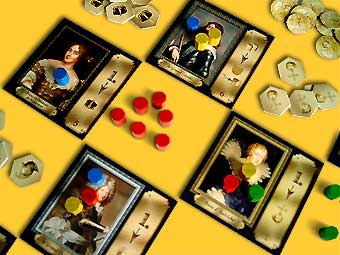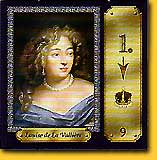Louis XIV
page 2
| x |
|
|
|
|
|
|
|
|
|
|
|
|
|
|
|
|
|
|
|
|
|
|
|
|
|
|
 |
|
When there’s a specific number of influence tokens depicted on a card, all players with that number of tokens receive the reward. On the card that contains the Louis XIV figure, the player with the highest number of influence tokens receives a crown-mission chip in addition to the normal reward. All influence tokens are returned to either the general or the personal reserve of the players. If a player obtained a first place on a character card, these influence tokens are returned to the general reserve.
|
| x |
|
|
|
|
|
|
|
|
|
|
|
|
|
|
|
|
|
|
|
|
|
|
|
|
|
|
| All players that didn’t get a first place take their tokens back to their personal reserves. Subsequently, all character cards where somebody got a first place are flipped over: the back side shows a table with the same reward, but a different condition (for example a first place, or a specific number of influence tokens). Everything can be altered at the very last moment using the intrigue cards. These cards also show a portrait of one of the relations of the king, just like the influence cards. When a character card is about to be scored, an intrigue card can be played, which allows the player to place 1 additional influence token from the general reserve, or 2 additional tokens from his personal reserve, on this character card. |
 |
| x |
|
|
|
|
|
|
|
|
|
|
|
|
|
|
|
|
|
|
|
|
|
|
|
|
|
|
|
|
|
In phase 4 the players can fulfil secret missions. Each player always has two mission cards in his hand. They show two mission chips, which represent the building costs. For a question mark, a random mission chip can be used, and a crown can be used as a wild card. Additionally, each card allows a special action, like taking extra money or influence tokens in phase 1, or placing free influence tokens on specific character cards at the beginning of the influence phase. After paying for a mission, the mission card is placed face up on the table and the special action can then be used once per round. After playing a mission card, the player immediately draws a new card from the pile. Players can fulfil as many missions as they can pay for. Only one mission chip can be kept for the next round, the surplus has to be discarded! |
| x |
|
|
|
|
|
|
|
|
|
|
|
|
|
|
|
|
|
|
|
|
|
|
|
|
|
|
After phase 4, a new round starts with phase 1. The game ends at the end of round 4. Then, all the now useless materials such as unused mission chips, intrigue cards and money are exchanged for shields. Shield tokens can also be obtained earlier in the game, from some character cards. At the end of the game all shield tokens are placed face up, and the players determine who has the most of each type (there’s six of them). This player receives an additional, blind, shield token. After scoring all types of shields, the victory points are counted. Each shield token scores 1 point, and each completed mission card scores 5 points. The player with the most victory points is the winner.
|
  |
 |
|
|
|
|
|
|
|
|
|
|
|
|
|
|
|
|
|
|
|
|
|
|
| The setup of Louis XIV is one hell of a job. Although the game looks really great, the mission chips are very difficult to distinguish from a distance. Also, the symbols on the character cards that show what type of reward can be obtained are not always easy to interpret. Add to that the very detailed rules that are difficult to remember, for example what influence tokens go back to the general- or to the personal reserve, and in what situations a character card has to be flipped over. |
| x |
|
|
|
|
|
|
|
|
|
|
|
|
|
|
|
|
|
|
|
|
|
|
|
|
|
|
 |
This makes Louis XIV a relatively complicated game for inexperienced players. It’s not difficult, but there’s a lot to explain, a lot to remember and lots of details. However, for people who have taken the trouble to master all of this, it shouldn’t be a problem. For those players, Louis XIV is a fun and beautifully designed majority-game. With some adjustments, it also plays very well with two players. The mission cards are probably most important in the game, since they are worth lots of points and also allow nice bonus actions. The shield tokens are then less interesting. But if all players use this same strategy, the shield tokens can be a nice tiebreaker. |
|
|
|
|
|
|
|
|
|
|
|
|
|
|
|
|
|
|
|
|
|
|
|
|
|
|
|
Because the game lasts only four rounds, the penalty for having one ‘bad round’ is rather high. On the other hand, this also brings back the duration of the game to little over an hour.
© 2006 Barbara van Vugt
Louis XIV, Rüdiger Dorn, Ravensburger, 2005 - 2 to 4 players, 12 years and up, 75 to 100 minutes.
|
|
 |
  |
|
|
|
|
|
|
|
|
|
|
|
|
|
|
|
|
|
|
|
|
|
|
  |
|
|
|
|
|
|
|
|
|
|
|
|
|
|
|
|
|
|
|
|
|
|
  |
|
|
|
|
|
|
|
|
|
|
|
|
|
|
|
|
|
|
|
|
|
  |
|
|
|
|
|
|
|
|
|
|
|
|
|
|
|
|
|
|
|
|
|
  |
|
|
|
|
|
|
|
|
|
|
|
|
|
|
|
|
|
|
|
|
|
  |
|
|
|
|
|
|
|
|
|
|
|
|
|
|
|
|
|
|
|
|
|
| x |
|
|
|
|
|
|
|
|
|
|
|
|
|
|
|
|
|
|
|
|
|
|
|
|
|
|
| x |
|
|
|
|
|
|
|
|
|
|
|
|
|
|
|
|
|
|
|
|
|
|
|
|
|
|
 |
|
|
|
|
|
|
|
|
|
|
|
|
|
|
|
|
|
|
|
|
|
|
 |
|
|
|
|
|
|
|
|
|
|
|
|
|
|
|
|
|
|
|
|
|
|
 |
|
|
|
|
|
|
|
|
|
|
|
|
|
|
|
|
|
|
|
|
|
|
| x |
|
|
|
|
|
|
|
|
|
|
|
|
|
|
|
|
|
|
|
|
|
|
|
|
|
|
 |
|
|
|
|
|
|
|
|
|
|
|
|
|
|
|
|
 |
|
|
|
|
|
|
|
|